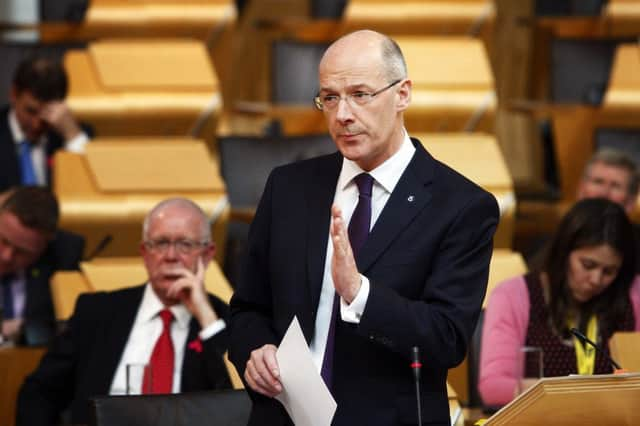Leaders: Swinney steers towards a high-tax economy


The account of his intentions which John Swinney, Scotland’s finance secretary, presented to MSPs yesterday could not be clearer. It looks like a laudable benefit to lower income earners, but the increased levy on middle earners and the clobbering of the rich may be a signal which damages the Scottish economy.
His announcement of the thresholds and rates for the Scottish government-controlled Land and Buildings Transaction Tax which will replace the Westminster-run stamp duty played to an obvious political gallery. Many at lower income levels will pay less tax, almost as many middle-income earners will pay a bit more, and the few rich people will pay a lot more.
Advertisement
Hide AdAdvertisement
Hide AdNo doubt many, and not just those who will benefit from the property transaction tax rates announced by Mr Swinney, will applaud that. The finance minister praised his own decision as essentially Scottish, or fitting the perceived Scottish desire that the burden of tax should essentially fall on the rich. Unfortunately for them and Mr Swinney, such simplicities do not necessarily fit easily into the complex modern money world. The immediate effect is likely to be a disruption in the property market. Buyers who would benefit could delay purchases until next April, when the new tax takes effect, and buyers facing an increased bill would rush to complete a deal before April.
The longer-term effects are also likely to negate Mr Swinney’s good intentions. If the lower rate LBTT has the effect Mr Swinney desires – of encouraging more first-time and lower-income buyers – then more people will enter the property market, driving prices up and resulting in people having to pay the same total amount for a property, even though the tax element might be lower.
At the upper end, awareness of a hefty tax to be paid on buying a house will mean that buyers adjust their purchasing budgets to pay less to the seller in compensation for the extra tax which will go to Mr Swinney.
He argues that 45 per cent of current purchasers will be paying less tax. That means 55 per cent will be paying more tax. Since the extra tax kicks in at the relatively modest £325,000 price mark, this is a tax increase that will hit people of relatively modest means.
This is potentially a very damaging signal. As more tax powers, including possibly virtually complete control of income tax, are set to be devolved, continuing to follow this pattern tells both existing high earners who might contemplate moving to Scotland, and Scots who aspire to be high earners, that Scotland is likely to be a high-tax country.
Since encouraging both these type of people is important for generating growth, the ultimate effect of this tax may do more damage than good.
Roll up and save this institution
Street markets, a kind of pop-up shopping experience invented long before the idea of pop-up shops, tend to wax and wane in popularity both with vendors and buyers. So if one stops happening, those who used it think it a shame it is no more but then move on.
Advertisement
Hide AdAdvertisement
Hide AdSuch cannot be said about the Lammas Market in St Andrews. This annual fair has been a much-anticipated annual event in the town dating all the way back to medieval times. It is said to be one of the oldest street fairs in Europe.
It doesn’t so much occur in the town as take it over for the weekend, occupying one and a half of the three main thoroughfares. Apart from providing food, clothing and household goods shopping, there are funfair attractions and street entertainment, all drawing thousands of visitors to the town, benefiting permanent traders.
But now it is under threat. Traders complain that the rents charged for a space are too high; last year, the array of stalls was a little gap-toothed as a result. The rental income is useful; usually it goes to subsidise the Byre Theatre, another St Andrews institution which has struggled to survive.
The town must take this threat to the Lammas Market seriously. The infrastructure of the fair may be entirely transient, but the event itself should be regarded as important a historical artefact as the cathedral or the castle.
It is a highly significant part of social history, part of the people’s heritage, and without society and people there would be little by the way of built heritage to treasure. A bit of imagination can surely save the Lammas Market. Roll up, roll up, have a try. Let’s hope we are all winners.